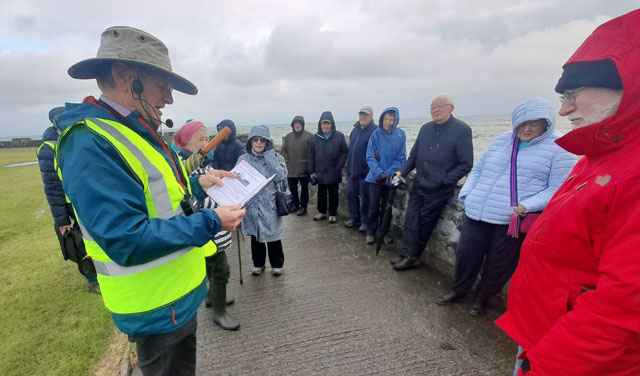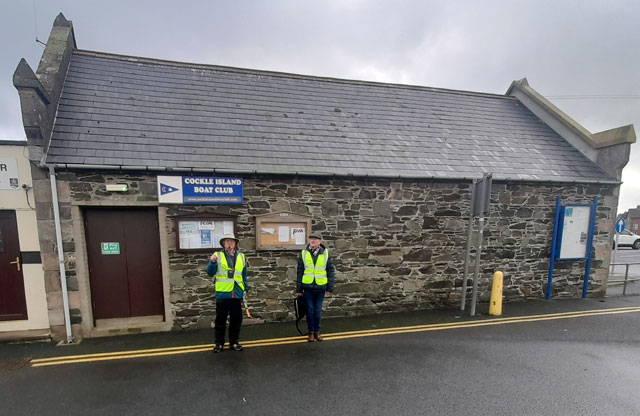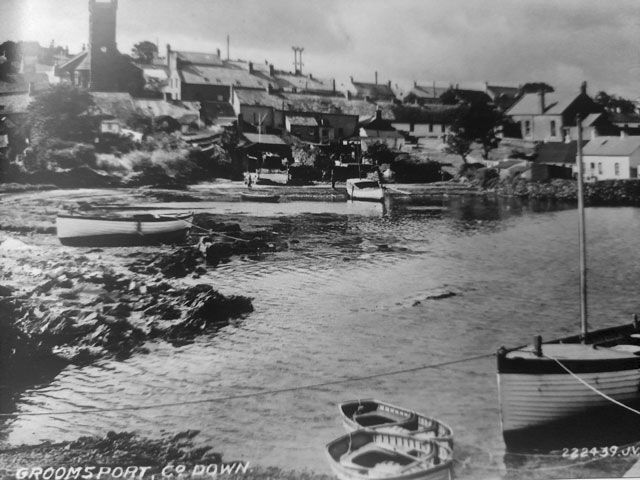Bangor Historical Society’s 2023 autumn outing took place on 28 October. A group of hardy members assembled in inclement weather at Cockle Row in Groomsport. The guide for a walk round the village was Peter Gibson of the Discover Groomsport group. He was assisted by Jim McMullan.

The first stop was to view the watch house on the left-hand side of the harbour. It was built in 1821 and used by the Coast Guard for over 80 years. The adjoining Coast Guard Cottages were demolished in the 1960s. In the middle of the harbour sits Cockle Island, a nesting site for birds. It is owned by the National Trust.
Peter explained that the harbour had been developed over the centuries, acquiring a pier and quay. It was mostly used by fishermen. At one time in the nineteenth century there were 20 boats and 80 fishermen based in the harbour. Cockle Row once housed fishermen and their families. It may date from the seventeenth century and was built at right angles to the sea to give protection from the wind. The houses were saved from demolition in the 1960s and now serve as a tourist office and small heritage centre.
The Eagle Wing was a sailing ship which tried to sail to America in 1636. Its passengers were Presbyterians from County Down who gathered in Groomsport and hoped to find freedom of worship in the New World. Unfortunately the ship encountered bad storms and it was decided to return to Belfast Lough. The next stop was on the right-hand side of the harbour at The Boathouse. This was designed by Sir Charles Lanyon and built in 1858 to house the first lifeboat in the Belfast Lough area. The lifeboat saved 87 lives before ending its service in 1920.

The next few places were all connected to the Perceval-Maxwell[originally Maxwell] Family which had been granted the townland of Groomsport among other local properties in the late seventeenth century. Peter explained the complicated genealogy of the family. In 1856 Robert Perceval-Maxwell built a wall to stop villagers passing along the path in front of his house. This led to local protests as well as the threat of legal action by the Admiralty. The part of the wall blocking the path was then removed. Groomsport House was built by John Waring Maxwell for his heir Robert Perceval-Maxwell in 1848. At one time it required 40 staff to look after the house and grounds. It was used by American soldiers during the war. The family sold the house in 1968. It became a hotel and now is divided into apartments.
The Parish church was built in 1841 to the design of Sir Charles Lanyon. John Waring Maxwell gave the land and money towards its construction. Additions were made to the church in the early 20th century. The Lodge was originally built as the rectory. Later Selina, the widow of Robert Percival-Maxwell’s eldest son, lived there. It was sold after her death in 1928. The Maxwell Hall was built in 1894 by Robert Perceval-Maxwell and served as a Sunday school at first. It was later gifted to the Parish Church.

Then members walked up to the street known as The Hill and originally as Upper Row. These houses were once fishermen’s cottages. The area was also the site of Groomsport’s first National school, built behind the Presbyterian Church in 1845. In the space between the school and The Hill the Rev Isaac Mack built four houses for the less-well off, known as Providence Place. The Presbyterian Church was built on Main Street in 1843. Neither of the local landowners, John Waring Maxwell and Lord Dufferin were willing to contribute to the cost. The church has been altered in the second half of the 20th century. The Walter Nelson Hall was opened in 1895 as the village’s second National school. When it closed in 1962 it became the Presbyterian Church Hall and was named after a long-serving minister.
The group then returned to the harbour area to view two memorials. One was the War Memorial unveiled in 1924. The other was the Schomberg Monument, which was erected in 1952. It commemorates the Duke of Schomberg, William III’s commander-in-chief, who according to tradition landed in Groomsport on his way to Belfast and later the Boyne. Another view is that he actually landed at Ballyholme Bay, now considered part of Bangor.

The chairman thanked Peter Gibson for an excellent and informative walk. More information is available on the group’s website [discovergroomsport.com] and copies of a leaflet for a self-guided walk are available at Cockle Row. The group has also offered guided walks of the village. Details of these appear on the website and can be booked online.
